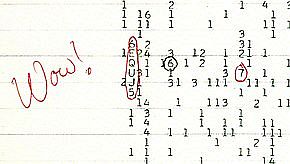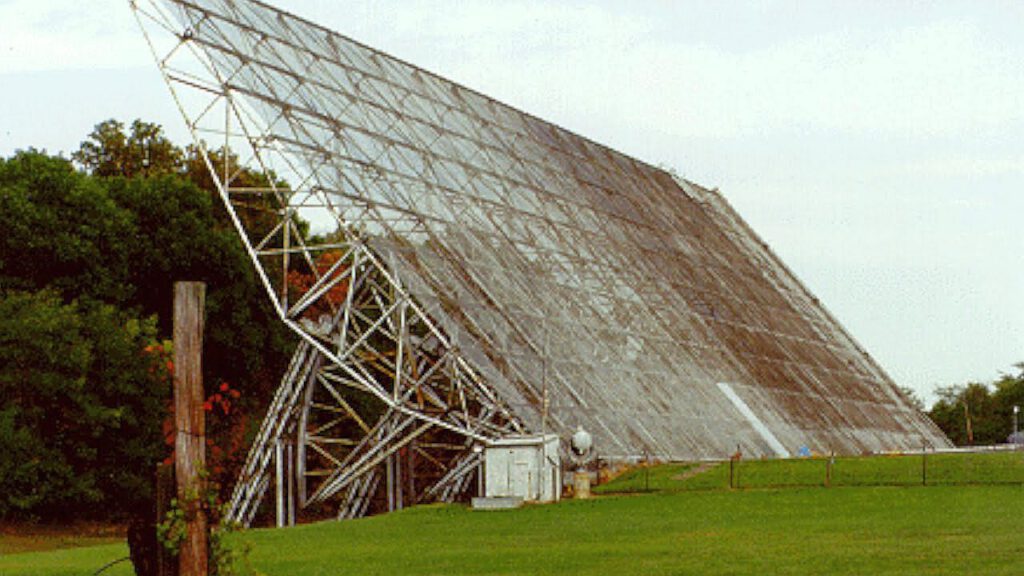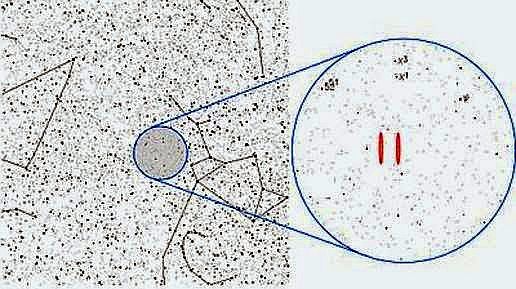In een vorige blog besprak ik de Breakthrough Initiatives en hun Breakthrough Listen Candidate 1. Dit buitenaardse signaal uit de regio Proxima Centauri was echter niet het eerste.
Eerder was er de Wow! signaal.
Hieronder enkele details die ik op Wikipedia vond:
De Wow! signaal was een sterk radiosignaal dat op 15 augustus 1977 werd gedetecteerd door de Big Ear-radiotelescoop van de Ohio State University in de Verenigde Staten en vervolgens werd gebruikt om de zoektocht naar buitenaardse intelligentie (SETI) te ondersteunen.
Het signaal leek uit de richting van het sterrenbeeld Sagittarius te komen en droeg de verwachte kenmerken van buitenaardse oorsprong. Astronoom Jerry R. Ehman ontdekte de anomalie een paar dagen later terwijl hij de geregistreerde gegevens bekeek. Hij was zo onder de indruk van het resultaat dat hij op de computerafdruk de aflezing van de signaalintensiteit “6EQUJ5” omcirkelde en de opmerking “Wow!” ernaast, wat leidt tot de veelgebruikte naam van het evenement.

De hele signaalreeks duurde het volledige venster van 72 seconden waarin Big Ear het kon waarnemen, maar is sindsdien niet meer gedetecteerd, ondanks verschillende daaropvolgende pogingen van Ehman en anderen. Er zijn veel hypothesen naar voren gebracht over de oorsprong van de emissie, inclusief natuurlijke en door de mens veroorzaakte bronnen, maar geen van hen verklaart het signaal adequaat.
Hoewel het Wow! signaal geen detecteerbare modulatie had – een techniek die wordt gebruikt om informatie via radiogolven te verzenden – het blijft vanaf 2021 de sterkste kandidaat voor een buitenaardse radiotransmissie die ooit is gedetecteerd.
Achtergrond van het Wow! signaal
In een artikel uit 1959 hadden de natuurkundigen Philip Morrison en Giuseppe Cocconi van Cornell University gespeculeerd dat elke buitenaardse beschaving die via radiosignalen probeert te communiceren, dit zou kunnen doen met een frequentie van 1420 megahertz (spectraallijn van 21 centimeter), die van nature wordt uitgezonden door waterstof, de meest voorkomende element in het universum en daarom waarschijnlijk bekend bij alle technologisch geavanceerde beschavingen.
In 1973, na het voltooien van een uitgebreid onderzoek van extragalactische radiobronnen, wees de Ohio State University het inmiddels ter ziele gegane Ohio State University Radio Observatory (bijgenaamd “Big Ear”) toe aan de wetenschappelijke zoektocht naar buitenaardse intelligentie (SETI).
De radiotelescoop bevond zich nabij het Perkins Observatory op de campus van de Ohio Wesleyan University in Delaware, Ohio.

In 1977 werkte Ehman als vrijwilliger bij het SETI-project; zijn werk omvatte het met de hand analyseren van grote hoeveelheden gegevens die door een IBM 1130-computer waren verwerkt en op lijnprinterpapier waren vastgelegd. Terwijl hij de gegevens bekeek die op 15 augustus waren verzameld, zag hij een reeks waarden van signaalintensiteit en frequentie die hem en zijn collega’s verbaasden. Het evenement werd later in technisch detail gedocumenteerd door de directeur van het observatorium.
Meting van 6EQUJ5
De string 6EQUJ5, vaak verkeerd geïnterpreteerd als een bericht gecodeerd in het radiosignaal, vertegenwoordigt in feite de intensiteitsvariatie van het signaal in de loop van de tijd, uitgedrukt in het specifieke meetsysteem dat voor het experiment is gebruikt. Het signaal zelf leek een ongemoduleerde continue golf te zijn, hoewel elke modulatie met een periode van minder dan 10 seconden of langer dan 72 seconden niet detecteerbaar zou zijn geweest.
De signaalintensiteit werd gemeten als signaal-ruisverhouding, waarbij de ruis (of basislijn) werd gemiddeld over de afgelopen paar minuten. Het signaal werd gedurende 10 seconden bemonsterd en vervolgens door de computer verwerkt, wat 2 seconden duurde. Daarom werd elke 12 seconden het resultaat voor elk frequentiekanaal afgedrukt als een enkel alfanumeriek teken, dat de gemiddelde intensiteit van 10 seconden vertegenwoordigt, minus de basislijn, uitgedrukt als een dimensieloos veelvoud van de standaarddeviatie van het signaal.
In deze specifieke intensiteitsschaal duidde een spatie een intensiteit aan tussen 0 en 1, dat wil zeggen tussen de basislijn en één standaarddeviatie erboven. De nummers 1 tot 9 gaven de overeenkomstig genummerde intensiteiten aan (van 1 tot 9); intensiteiten van 10 en hoger werden aangegeven met een letter: “A” kwam overeen met intensiteiten tussen 10 en 11, “B” met 11 tot 12, enzovoort.
De Wow! de hoogst gemeten waarde van het signaal was “U” (een intensiteit tussen 30 en 31), dat is dertig standaarddeviaties boven achtergrondruis.
John Kraus, de directeur van het observatorium, gaf een waarde van 1420,3556 MHz in een samenvatting uit 1994, geschreven voor Carl Sagan. Ehman gaf in 1998 echter een waarde van 1420,4556 ± 0,005 MHz. Dit is (50 ± 5 kHz) boven de waarde van de waterstoflijn (zonder rood- of blauwverschuiving vanwege het Doppler-effect) van 1420,4058 MHz.
Als dit vanwege de blauwverschuiving zou zijn dan betekent dat dat de bron ongeveer 10 km/s naar de aarde beweegt.
Waar komt het Wow! signaal vandaan?
De precieze locatie aan de hemel waar het signaal blijkbaar vandaan kwam, is onzeker vanwege het ontwerp van de Big Ear-telescoop. Die had twee voedingshoorns, die elk een straal uit iets verschillende richtingen ontvingen, terwijl ze de rotatie van de aarde volgden.
Het Wow! signaal werd gedetecteerd in de ene straal maar niet in de andere. De gegevens werden zo verwerkt dat het onmogelijk is om te bepalen welke van de twee hoorns het signaal heeft ontvangen. Er zijn dus twee mogelijke waarden voor de locatie van het signaal.

Het gebied van de hemel in kwestie ligt ten noordwesten van de bolvormige sterrenhoop M55, in het sterrenbeeld Sagittarius, ongeveer 2,5 graden ten zuiden van de sterrengroep Chi Sagittarii.
De dichtstbijzijnde goed zichtbare ster is Tau Sagittarii.
Hypothesen over de oorsprong van het signaal
Er zijn een aantal hypothesen naar voren gebracht met betrekking tot de bron en aard van het Wow! signaal. Geen van hen heeft brede acceptatie gekregen. Interstellaire scintillatie van een zwakker continu signaal – vergelijkbaar met atmosferisch twinkelen – zou een verklaring kunnen zijn, maar dat sluit niet uit dat het signaal van kunstmatige oorsprong is.
Andere hypothesen zijn onder meer een roterende vuurtorenachtige bron, een signaal dat in frequentie zwaait of een eenmalige uitbarsting.
Ehman heeft gezegd: “We hadden het opnieuw moeten zien toen we er 50 keer naar zochten. Iets suggereert dat het een signaal van de aarde was dat gewoon werd weerkaatst door een stuk ruimtepuin.” Later herriep hij zijn scepsis enigszins, nadat verder onderzoek had aangetoond welke onrealistische vereisten een reflector zou moeten hebben om het waargenomen signaal te produceren.
De frequentie van het signaal van 1420 MHz maakt ook deel uit van een beschermd spectrum: een frequentiebereik gereserveerd voor astronomisch onderzoek waarin “aardse” uitzendingen verboden zijn. In een paper uit 1997 verzet Ehman zich tegen “het trekken van enorme conclusies uit half-grote gegevens” – waarbij hij de mogelijkheid erkent dat de bron mogelijk militair was of anderszins een product van aardgebonden mensen.
METI-president Douglas Vakoch vertelde Die Welt dat eventuele vermeende SETI-signaaldetecties ter bevestiging moeten worden gerepliceerd, en het ontbreken van een dergelijke replicatie voor het Wow! signaal betekent dat het weinig geloofwaardig is.
